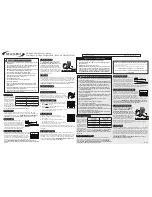
BOP-1K-GL 111315
3-17
3.4.1.1
FIXED GAIN USING EXTERNAL REFERENCE CONTROL
The main channel of the BOP, voltage in voltage mode, and current in current mode, can be
controlled by an external reference voltage, 0 to ±10V applied at pin 11, referenced to pin 10, of
the Analog I/O port. The input impedance for this signal is 20K ohms.
NOTE: Power-up switch S3 must either be set to 00000 or S3-2 and S3-5 must be set to 1
(on) prior to power-up, otherwise the analog reference signal applied to Analog
I/O Port pin 11 will have no effect.
When the external reference is used, the BOP functions as a power amplifier, amplifying the
external reference at pin 11 to produce the output.
The nominal (inherent) voltage gain of each model is calculated by (G
NOM-V
) = E
Onom
/ E
REF
.
and nominal (inherent) current gain is (G
NOM-I
) = I
Onom
/ E
REF
. Thus the nominal gain is the ratio
between the nominal (rated) voltage or current (E
Onom
or I
Onom
), and the external reference
(E
REF
) used to produce that output.
So for an external reference of ±10V, the nominal voltage gain (G
NOM-V
) = E
NOM-V
/10, e.g., the
voltage gain of a BOP 36-28GL is 36/10 = 3.6. The nominal current gain (G
NOM-I
) is I
NOM-V
/10,
e.g., the current gain of a BOP 36-28GL is 28/10 = 2.8.
The external reference voltage may be d-c, a-c, or a combination of a-c plus d-c. The maximum
frequency of an a-c signal should be below the inherent frequency response of the BOP (1KHz
for voltage, 800Hz for current (see Table 1-2). For parallel or series combinations, the frequency
response is reduced as specified in the instruction manual included with the cable kit. A fre-
quency that exceeds the bandwidth of the BOP will cause the output to be distorted.
For linear response (input vs. output) the software limit (see 3.3.5) should be set to nominal and
the maximum peak value (d-c plus a-c) of the reference signal must not exceed ±10V. If the
input signal exceeds the limit value (either ±10V if the software limit is set to nominal, or a lesser
voltage for a user-determined software limit) clipping of the output voltage or current to the limit
will occur.
NOTE: If the system limits have been modified (PAR. 3.3.5), the output of the power supply will
never exceed the modified system limits. E.g, for a BOP 36-28GL, if the system voltage
limit is modified to ±18V, applying a positive analog voltage to pin 11 that starts at zero
and rises to +10V causes the output to rise from zero and reach +18V when the exter-
nal reference r5V. The output stays at +18V while the reference increases
from +5V to +10V since the system voltage limits for this example are ±18V.
The command sequence that can be used is:
FUNC:MODE VOLT
Sets unit to voltage mode.
VOLT:LIM 18
Sets main channel (voltage) software limits to ±18V.
CURR:PROT 20
Sets protection level to ±20A.
To restore all the above settings for power up, send *SAV3. This saves the settings to memory
location 3 (locations 1 through 15 can be used to establish initial power-up conditions). Set
power-up switch S3 to 00011 when performing a normal power-up (PAR. 3.3.2.2) to restore the
saved settings upon power up: main channel set to voltage, voltage limits set to ±18V and cur-
rent protection set to ±18A.
Summary of Contents for BOP-GL 1KW
Page 2: ......
Page 10: ......
Page 20: ...x BOP 1K 111315 FIGURE 1 1 HIGH POWER BOP GL SERIES POWER SUPPLY...
Page 36: ...1 16 BOP 1K GL 111315 FIGURE 1 3 BOP OUTPUT CHARACTERISTICS...
Page 38: ......
Page 116: ......
Page 128: ......
Page 174: ......
















































